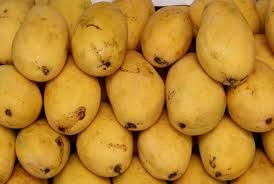It’s summer and we are experiencing intolerable heat. But one good thing about this season is we can enjoy the delicious fruit of summer – Mango. Known as the ‘King of Fruits’, this tasty, juicy, sweet and fleshy fruit has lovers the world over. If you are one of them and planning to buy a bag of them, beware! Market is filled with artificially ripened mangoes that pose a possible health hazard.
Calcium carbide, a banned chemical agent, is extensively used to ripen mangoes. Artificially ripened mangoes (using carbide) not only taste bland they also cause health problems. If you continuously eat carbide treated mangoes, it leads to acute health problems like stomach upset, peptic ulcer, vomiting, diarrhoea and may also lead to chronic conditions like cancer. Moreover, these mangoes will generate more heat in the body, compared to naturally ripened ones.

Naturally Ripened Mangoes
If you want to avoid such complications, you have no choice except going for naturally ripened, chemical-free mangoes. With a little effort you can easily differentiate carbide treated ones from the naturally ripened ones. Remember mango sellers are smart, they never accept that mangoes are chemically treated. So, the onus is on you to identify the good ones. Following are a few tips to identify chemically ripened mangoes.
Tips to identify carbide ripened mangoes
- Colour – Carbide ripened mangoes are uniformly coloured and appear bright yellow in colour. They look more appealing than the naturally ripened mangoes. On the other hand, naturally ripened mangoes will be in orangish to reddish shades. Though carbide treated mangoes appear ripe, the inner part will be raw, appears in creamy shade and tastes sour.

Carbide-Ripened Mangoes
![]()
- Appearance –Carbide treated mangoes have wrinkle-free and hard texture while naturally ripened mangoes will have soft skin. Further, chemically treated mangoes will get spoiled quickly as the carbide accelerates the ripening process and overtime they may also develop black patches on the outer surface.
- Aroma – Carbide ripened mangoes are less likely to have the natural aroma of mangoes. Unless you smell them hard you cannot get the aroma. Contrast to this, naturally ripened ones smell great even from far.
- Taste – Carbide affects the sugar formation in mangoes and thus they taste less sweet and tasteless compared to naturally ripened mangoes.
Precautions to take care while having carbide treated mangoes
In case, you find only chemically treated mangoes and nothing else at your place, take these precautions that could reduce the chemical’s effect.
- Soak mangoes in a tub of water and add hand full of salt. Leave them for 20–30 minutes. Then take them out and keep in plain water and leave for 10-15 minutes. After 15 minutes take them out, dry them with a clean cloth. Do this before keeping them in the refrigerator. (You can
 certainly feel the smell of chemical in the tub bucket of water).
certainly feel the smell of chemical in the tub bucket of water).
- Wash mangoes for 1-2 minutes with warm water. Peel the skin (if possible) before eating.

